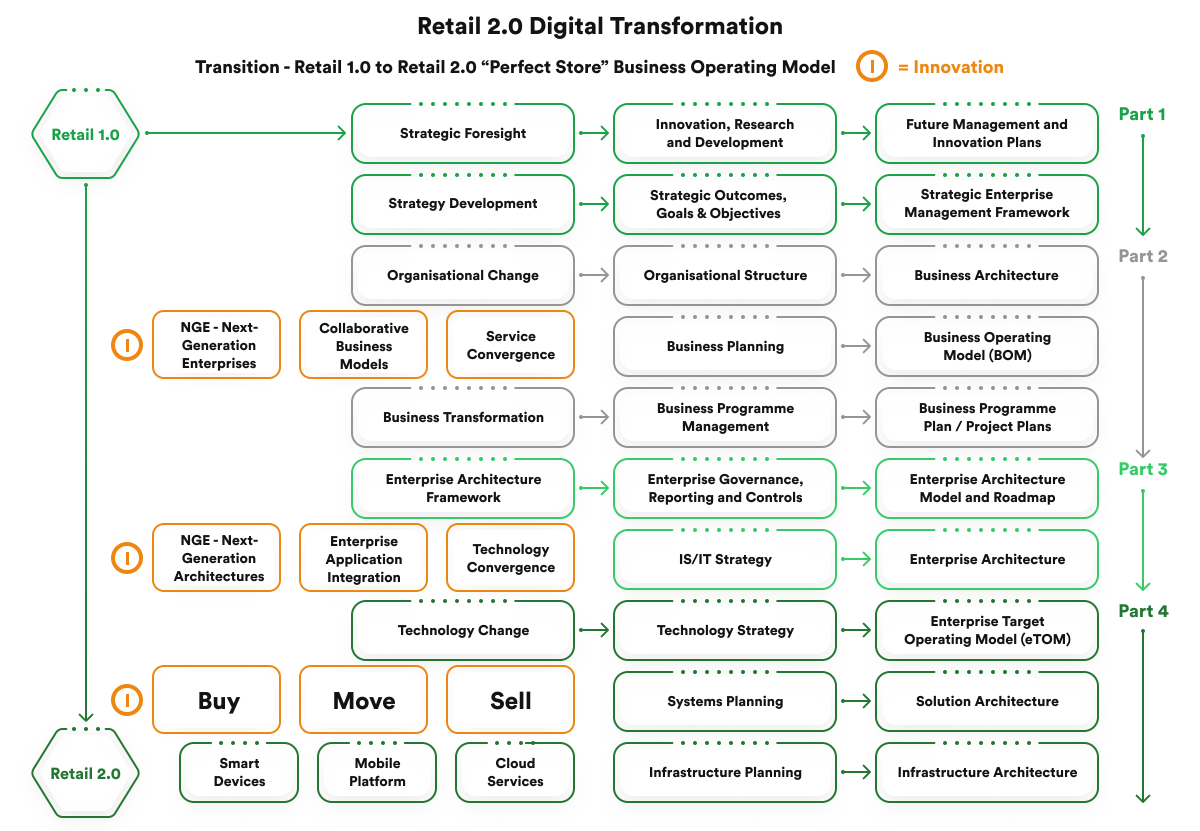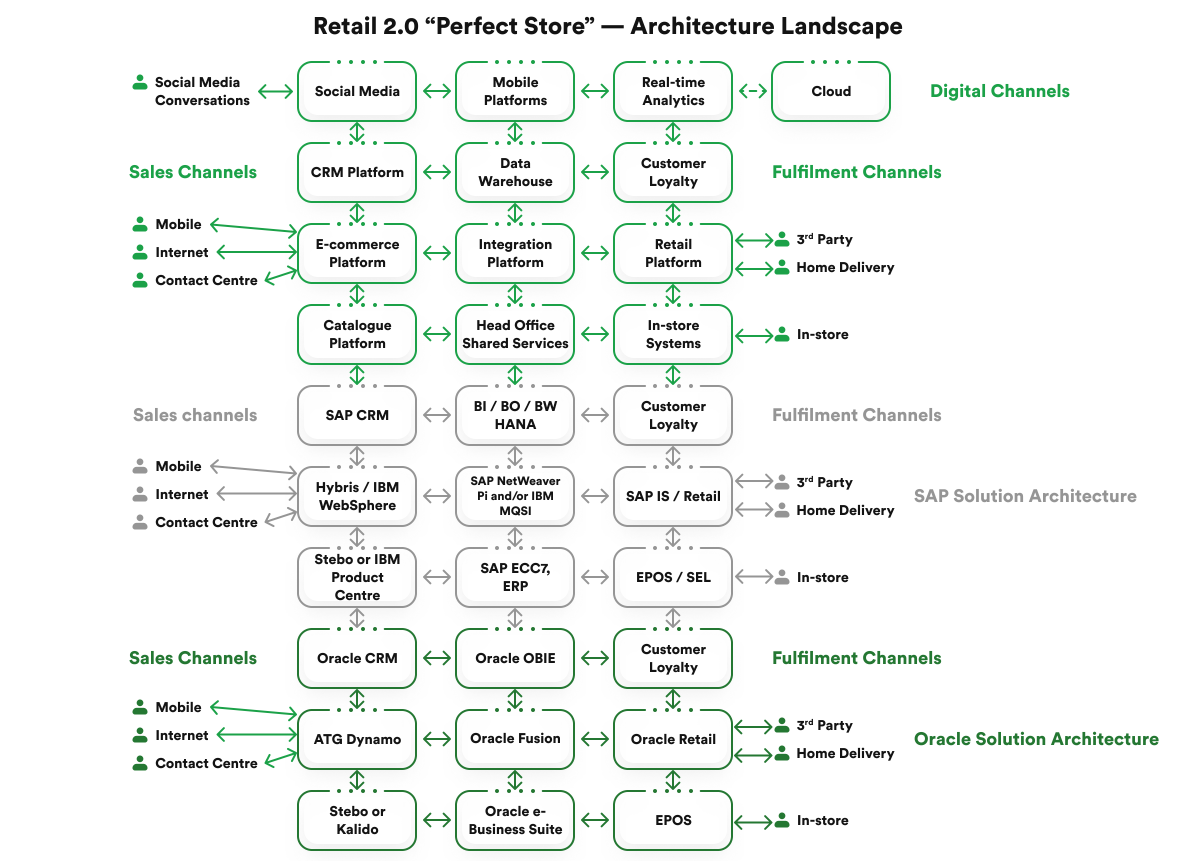
Omnichannel Retail: Technologies, Challenges, and Opportunities
This article explores omnichannel retail. It covers its advantages, the technology driving it, the implementation challenges companies face, and future trends.
The Retail Automation market is expected to reach an impressive value of $29,766.77 million by 2030, indicating that it is set for solid growth. The increasing desire for digitization and the widespread implementation of retail automation solutions across various retail venues, including supermarkets/hypermarkets, specialty shops, and other retail outlets, are the main drivers of this rising trend.
Retail automation is a collection of automated processes that combines hardware and software solutions to handle several aspects of the retail industry, including product management, personnel management, inventory management, and shop audits. Retail automation often includes self-service processes and standalone kiosks that operate as fully automatic retail enterprises. Retailers are being forced by increased margin pressure to select unique approaches that will set them apart in a crowded market. Also, the growth of global e-commerce has proven very beneficial for the retail automation industry.
In the ever-evolving retail landscape, the emergence of Retail 2.0 is reshaping how consumers shop and interact with brands. Central to this transformation is the remarkable surge in automation, a powerful technological force key to unlocking a new realm of efficiency, personalization, and innovation.
The foundation of increased efficiency in Retail 2.0 is automation. Retailers can improve operations and increase efficiency by automating manual and routine procedures. Automated systems can quickly take over mundane duties like inventory counting, price adjustments, and standard paperwork. In addition to reducing the time spent on these tasks, this also lessens the possibility of mistakes brought on by human exhaustion.
Customer experience is a top priority in Retail 2.0, and automation is crucial to establishing a personalized and immersive purchasing experience. For instance, consider the idea of virtual changing rooms. Customers can digitally try on clothing using augmented reality (AR) technology, experimenting with various sizes, colors, and styles without changing physically. With less clothing to try on, this saves time and improves the overall shopping experience.
The use of self-checkout technologies is another aspect of improved customer experience. These technologies let customers scan and pay for their purchases without a cashier. These speeds up the checkout procedure, reduce waiting times, and give customers more control over their shopping experience.
The opportunity for substantial cost savings is among the most persuasive arguments for retailers adopting automation. Many a retailer’s operating expenses are labor-related. Retailers can reduce labor costs while maintaining or increasing operational efficiency by automating operations previously completed by human personnel, such as handling cash, repetitive data entry, and manual inventory audits.
Automation also reduces losses brought on by mistakes, shrinkage, or theft. In-store video feeds can be analyzed by intelligent surveillance systems with AI to spot suspicious activity and potential theft, giving employees time to take appropriate action. This not only lowers losses but also makes stores safer for both consumers and staff to shop in.
A successful retail operation relies on efficient inventory management; automation is a game-changer. Real-time insights into stock levels, sales trends, and client preferences can be obtained using automated inventory systems. For instance, RFID (Radio-Frequency Identification) technology allows the tracking of specific products inside and outside the business. This makes it possible for merchants to keep the right amount of inventory, avoiding situations where there is a stockout or excess inventory that could result in lost sales opportunities or irrational carrying costs.
Additionally, automated systems can create purchase orders and replenish goods when stock levels hit specified thresholds. As a result, manual intervention is no longer needed, and customers can always purchase popular products, increasing their satisfaction.
Automation is the key to maximizing data value in the Retail 2.0 era. Data is a goldmine. The amount of data that can be gathered on consumer behavior, buying habits, and preferences through automated systems is enormous. Then, essential knowledge that guides decision-making can be gleaned by analyzing this data.
Consider a retail chain that tracks customer foot movement and examines which areas of the shop are the busiest using automated methods. By positioning high-demand goods in strategic locations, this data could assist in optimizing shop layout and increase sales.
Additionally, data analytics may make marketing campaigns extremely personalized. Automated systems can categorize customers based on their preferences and past purchases, enabling retailers to provide customized specials and recommendations that increase conversion rates.
In retail, e-commerce has been a defining trend, and automation is crucial to effective e-commerce operations. Retailers must ensure that orders are fulfilled smoothly, refunds are processed quickly, and customers are catered to as online shopping grows.
To overcome these difficulties, automation solutions are essential. Online orders may be completed quickly and precisely using automated warehouse management systems to speed up picking and packing. Computerized chatbots can offer round-the-clock customer service, responding to questions and resolving problems in real time, improving the online purchasing experience.
Differentiation is essential for surviving in the current retail environment of intense competition, and automation presents a unique way to achieve this differentiation. Retailers that invest in automation technology and use them effectively distinguish themselves as leaders in efficiency and innovation, establishing themselves as the go-to places for tech-savvy customers.
For instance, a retail chain may use a cutting-edge interactive display that uses AI to provide product recommendations based on a customer has chosen product. This improves the shopping experience and fosters a unique and memorable contact that distinguishes the retailer from rivals.
Automation in the retail industry has exploded thanks to technological innovations like artificial intelligence (AI), machine learning, robots, and the Internet of Things (IoT). These technological advancements have reached a stage where they can be effortlessly incorporated into retail operations, providing a degree of efficiency and capability that was previously unimaginable.
For instance, AI-powered chatbots can communicate with clients in natural language, offering them product recommendations, responding to their questions, and even completing orders. Machine learning algorithms can examine historical sales data to forecast future demand, which helps with inventory planning and replenishment methods.
Robotic systems can be used for various functions, including in-store customer service and warehouse automation. Imagine a scenario in which a robot leads a consumer through the store, educating them about the products and promptly assisting them in finding what they’re looking for.
The IoT makes it possible for numerous systems and devices to be connected, resulting in a network that can share and process real-time data. This might result in cutting-edge software, such as smart shelves, recognizing when a product is running low and immediately order restocking.
Automation is a vital resource for areas experiencing a labor shortage. Retailers frequently need help finding and keeping talented workers, especially for repetitious or physically demanding jobs. Even in personnel issues, automation can support the current crew and ensure operations operate smoothly.
Consider a scenario where a retail store suddenly sees a spike in foot traffic due to a promotional event. The business can set up self-checkout machines and computerized inventory tracking systems to efficiently handle the rush customers rather than attempting to find and train extra workers to handle the increased demand.

Modern retail operations are becoming more efficient thanks to automation. Retailers can create streamlined workflows that significantly increase productivity by automating time-consuming and repetitive tasks. Think about the procedure for replenishing shelves with new stock. In a conventional system, this might call for physical handling of the products, data input, and human checks. Smart sensors that are automated can track inventory levels in real-time and initiate automatic restocking when quantities fall below a predetermined level. This speeds up refilling and lowers the chance that products may run out of stock.
Although human error is unavoidable, automation may significantly reduce it. Accuracy is essential in retail for ordering, pricing revisions, and inventory management. Automated processes eliminate human subjectivity and weariness, resulting in more reliable results.
The possibility of significant cost reductions is one of automation’s primary benefits in retail. An essential amount of a retailer’s budget goes toward labor expenditures, and automating functions previously done by employees can result in significant savings on operational costs.
In Retail 2.0, providing a remarkable shopping experience is essential, and automation is crucial to attaining this objective. Automation adds comfort and customization that can significantly improve the client experience.
Automation generates abundant data that may be used to make educated decisions and streamline procedures. Automated systems gather and analyze data on consumer behavior, preferences, sales patterns, and other factors, giving merchants insightful knowledge that motivates strategic actions.
Successful retail companies depend on accurate inventory management, which automation makes more precise and efficient than ever before. Automated inventory systems give retailers real-time access to stock levels, allowing them to plan for replenishing and restocking.
Being able to scale their operations successfully is one of the difficulties many retailers encounter when scaling their business. Automation solves this problem by enabling retailers to grow without proportionately increasing labor costs.
Beyond simple task automation, automation plays a more significant part in reducing manual labor. Retailers may free up their personnel to focus on more important and customer-focused duties by automating repetitive and routine tasks.
Agility and reactivity are essential in the fast-paced world of retail. Automated systems thrive at responding quickly to changes, whether adapting to changes in customer demand or addressing problems in real time.
Ultimately, all the automation’s advantages lead to increased sales as the main result. Customers are more likely to make purchases and return for further transactions in an environment that benefits from automation, improved inventory management accuracy, personalized customer experiences, and data-driven insights.

Although there is no denying that automation has long-term advantages, many retailers may find the initial investment expensive. Using automation systems frequently involves hardware, software, integration services, and personnel training expenditures. These expenses can be particularly onerous for small and medium-sized retailers, necessitating careful planning and budgeting.
Integrating new automation technology with already-in-place systems and procedures can be difficult and time-consuming. Retailers frequently use outdated systems intended to work more smoothly with more modern automated alternatives. This integration difficulty may result in business interruptions, inconsistent data, and even shut down if not handled effectively.
The successful integration of new automation technologies with their existing infrastructure requires retailers to commit time and resources. This may entail cooperating closely with technology partners or seeking advice from specialists in systems integration to achieve a smooth transition.
Data security and privacy issues are brought up by the gathering, processing, and storing of sensitive consumer data during automation in the retail industry. More automation increases the possibility of cyberattacks, data breaches, and unwanted access.
Retailers must deploy strong cybersecurity safeguards to protect customer data and maintain compliance with data protection laws like the General Data Protection Regulation (GDPR) or the California Consumer Privacy Act (CCPA). This could entail using encryption, safe authentication procedures, and routine security audits to find and fix weaknesses.
Not all customers might quickly accept automation in the retail sector. Customers who desire a more individualized experience, particularly in areas like customer service or product recommendations, shop online. Customer resistance and unhappiness can result from the introduction of automation, especially if it could be more intuitive and user-friendly.
Offering both self-service and individualized support, retailers must achieve a balance between automation and human engagement. Employee education on automated systems’ advantages and simplicity can help allay client worries and promote adoption.
Automated systems are subject to technological issues, malfunctions, and downtime like any other technology. Operations delays, long lines at the register, and irate customers can all result from such interruptions. Even though downtime is a fact of life for every technological installation, it is crucial in retail because client pleasure is everything.
Before implementing automation solutions, retailers should implement rigorous testing methods to reduce the possibility of technical problems and downtime. The customer experience can be improved by having contingency plans and quick-response teams ready to address technological difficulties as soon as they arise.
Employee education is frequently needed to introduce automation and manage these new technologies efficiently. Due to this training’s time and resource demands, regular business operations must improve. Additionally, workers used to manual processes could be reluctant or unsure about picking up new technology.
Retailers should devote enough time and money to thorough training programs. Employees can become more comfortable and competent with the new technology, shortening the learning curve and increasing their job satisfaction by being given clear and concise training materials, hands-on workshops, and continuing assistance.
The potential loss of jobs, particularly in lower-skilled sectors vulnerable to automation, is one of the more divisive issues this technology raises. Automation may enhance productivity and reduce costs, but it also has the potential to eliminate jobs and leave the workforce unsettled.
Retailers should create a careful plan for managing the shift to automation to meet this risk. Employees may need to be retrained or upskilled for positions that support automated systems, such as driving and maintaining the technology or concentrating on client involvement. Clear communication and open planning can lessen concerns about job displacement and encourage a more favorable response from the workforce.
Some automation solutions may force businesses to rely significantly on particular vendors for continuing support, maintenance, and updates. If the vendor raises rates, modifies the conditions of service, or goes out of business, this dependence could become dangerous.
Before committing to an automated solution, retailers should carefully evaluate vendor relationships to help mitigate this problem. Choosing providers with a proven track record, providing vital support, and being dedicated to their product over the long term will help reduce the risk of being unduly dependent on only one.
While automation can increase productivity, not all systems are easily expandable or adaptive to shifting company requirements. Some technologies could be inflexible and need help to adapt to changes in consumer demand, product offerings, or retail environments.
Solutions that are scalable, flexible, and able to accommodate growth and changing requirements should be given priority by retailers. This could entail choosing simple modular solutions to modify or expand, ensuring that automation remains a benefit rather than a drawback as the company grows.
Regional differences in laws and regulations may impact the application of automation in retail. This encompasses data collecting, consumer rights, working conditions, etc. For retailers, especially those who operate in several different jurisdictions, navigating this regulatory complexity can take time and effort.
Retailers need to ensure that any automation they use complies with local standards. This may entail consulting legal specialists or regulatory advisors to ensure the automated systems follow the required norms and criteria.

This article explores omnichannel retail. It covers its advantages, the technology driving it, the implementation challenges companies face, and future trends.

A comprehensive overview of how fintech innovations drive significant changes in the retail industry.

In this article, we explore a current retail technology landscape and trends shaping the industry, retail tech use cases, as well as what the future holds for retail tech.
Copyright © 2023 rinf.tech. All Rights Reserved.
Terms & Conditions. Cookie Policy. Privacy Policy.
Politica Avertizari de Integritate (RO)